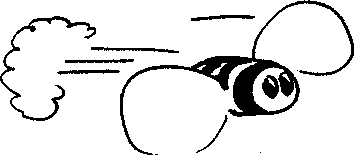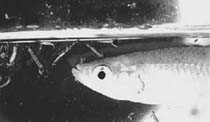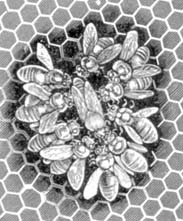 The
Plagues of Summer
The
Plagues of Summer The
Plagues of Summer
The
Plagues of Summer
by Don Kehne
By land, by air, by sea, nature's summer swarms have arrived. Slap, shoo, swat or squash all we might, we'll never free ourselves from their tyranny. Here's a rundown of what buzzes, bites, stings, swarms and otherwise spoils our summer fun, reminding us how much we miss the bone-chilling, teeth-chattering, gloriously pest-free days of winter
Diptera, My Dear?
Of all insects, the most pestilent to humankind are Diptera - the true flies, whose species includes not only flies but also mosquitoes, midges and gnats. With more than 120,000 species worldwide, there's more than enough variety to keep people slapping and swatting their summer days away.
Mosquitoes
A Calvert County Mosquito Program worker prepares for battle, below.
You're on the back porch at dusk, enjoying the day's last lingering hues. Suddenly, tiny wings whine softly at your ear. A moment later, you feel a sharp pin-stick at the nape your neck. You slap. You regard the smear of blood and bug guts on your palm. You scratch. A moment later, another whine. Another slap. Another scratch. Followed by another. And another. You rise from your chair. You go inside.
That scene should sound awfully familiar about now. Compliments of El
Niño, the great outdoors have become an even greater mosquito factory
than usual this year. State officials predict a bumper crop, making up for
last year's relatively mosquito-mild summer.
Mosquitoes - the word, by the way, comes from Spanish musketas, for "little fly" - come in a whole swarm of varieties, many of which, to give the devil her due, are not blood-suckers. What's more, only females feed on blood, which they need to produce eggs. Male mosquitoes, smaller of the two, feed on nectar or plant juices, which both sexes use for energy.
Of the blood-suckers, not all pick on humans. Some feed only on birds, some only on cold-blooded creatures. When and where mosquitoes feed varies widely as well. While most species are active at night, some are active only in daylight, and some, in both. While some feed only at ground level, others feed only among treetops. Some species dine locally, while others, such as certain salt marsh species of Chesapeake Bay, fly up to 20 miles for a meal.
Despite their differences, however, all mosquitoes share one thing: they need water to reproduce. Mosquitoes breed wherever there is still water - ditches, rot holes, containers, swamps, tidal salt marshes. With such a wet spring, breeding pools are easy to find.
When a female does find a suitable breeding spot, she will lay her eggs either on the water's surface or slightly above, depending upon the brand of mosquito. The three most common types of pest mosquitoes in southern Anne Arundel County - Aedes, Culex, Coquillettidia - have distinct preferences. Aedes mosquitoes, which includes our explosively populous salt marsh and floodwater varieties, lay eggs singly above the water line. The eggs remain dormant until covered by rising tides or rainwater. Culex mosquitoes, on the other hand, breed in pools of quiet standing water, preferably polluted, laying rafts of 100 or more eggs on the water's surface. Coquillettidia prefer marshes, laying eggs in rafts on the water's surface, particularly around cattails.
Wherever laid, once in contact with water, the eggs hatch into larvae
in a day or two. The s-shaped larvae, called "wigglers" due to
the way they move, breathe at the surface or through roots of aquatic plants
and feed on organic material suspended in the water. After about a week,
larvae turn into comma-shaped pupae known as "tumblers." In this
non-feeding stage, which lasts two or three days, mosquitoes transform into
adults, ready for their first meal.
How do mosquitoes hunt you down?
To find a host, mosquitoes use their antennae: first as long range radar to detect and home in on the carbon dioxide we exhale; then, once they get close, to sense our skin's lactic acid that identifies us, like a neon sign, as good eatin'. Finally, once they've touched down, heat-seeking sensors in the antennae and proboscis act as a divining rod to locate a plump blood vessel to tap. Insect repellents work by interfering with the antennae's receptors, confusing the mosquito.
Is a bite just a bite?
Because they often feed upon several hosts before filling their bellies, mosquitoes are particularly adept at spreading disease. In fact, one-fifth of the world's population is affected each year by such mosquito-borne diseases as malaria, yellow fever or dengue, parasitic worms, and encephalitis. Mosquitoes can't transmit AIDS because the HIV virus does not survive inside them.
In the United States, where pest control programs are well-established, mosquito-borne diseases are relatively rare.
Here in Maryland, mosquitoes have been responsible for three health hazards: eastern equine encephalitis, St. Louis encephalitis, and heartworms.
Eastern equine encephalitis or EEE, fatal to horses and life-threatening to humans, is caused by a virus found in wetland birds. The salt marsh mosquito Aedes sollicitans passes the disease from bird to humans. Infected horses can't pass disease to people, horses, or even other mosquitoes.
In the past, eastern equine encephalitis has been identified in two locations in Maryland: on the lower Eastern Shore, where it has harried pheasant and emu farmers, and in the swamps along the Patuxent River near Ft. Meade. The last case of EEE in Maryland occurred at an emu farm on the Eastern Shore in 1996, according Dr. Beth Karp of the Maryland Department of Health and Mental Hygiene.
In 1975, an outbreak of St. Louis encephalitis - another life-threatening disease passed from birds to humans by mosquitoes - occurred in the Baltimore-Washington area. The northern house mosquito, Culex pipiens, which breeds in polluted water, was identified at that time as the carrier of the disease.
Today, dog heartworm is the most common mosquito-borne disease in Maryland, transmitted by Aedes mosquitoes. The disease occurs only rarely in people, however.
Of concern to health officials lately are two potential threats: the Asian tiger mosquito, or Aedes albopictus, which is the primary carrier of dengue fever overseas, and the yellow fever mosquito, Aedes aegypti.
First introduced to the United States in 1985, Asian tiger mosquitoes found their way to Baltimore through the used tire trade. Mosquitoes have since spread to Prince George's, Montgomery, Charles, Talbot, Dorchester and Harford counties. Last year, the mosquitoes were found in Somerset County. This year, however, we may be lucky.
"We've haven't come across any so far," according to Patricia Ferrao, coordinator of Maryland Department of Agriculture's Mosquito Control Program. But, Ferrao added, the potential danger still exists. Since the mosquito will breed in any water-holding container, they can spread quickly. In addition, the mosquito is only active during the day, so spraying trucks operating at night aren't effective against them.
"Only community effort can control the Asian tiger mosquitoes. We can't go into every back yard, so we are asking people to reduce potential breeding sites around their homes," Ferrao said.
The other potential threat is Aedes aegypti, the primary carrier of yellow fever and dengue in Asia. While large pockets of Aedes aegypti arise each year in Maryland, their distribution is limited because they cannot survive our winters.
What's the best way to fend off mosquitoes?
First, forget the gadgets and gizmos. Bug zappers don't control mosquitoes effectively, experts agree. In fact, according to a recent study, mosquitoes make up less than one percent of a bug zapper's catch. Likewise, electronic repellers that claim to keep away bugs with ultra-sonic pulses do little more than repel hard-earned bucks from your wallet.
Ditto the citrosa plant, a genetically engineered houseplant designed to emit mosquito-repelling citronella. While the idea is nice, scientists say, the plant does not work.
Perhaps the easiest way to keep off mosquitoes is to avoid them. Stay inside, especially at dusk. Check porch and window screens for holes, patching or replacing torn screens with 16x16 or 14x15 mesh. Inside, coils, candles, citronella, peppermint or clove oils are all somewhat effective at keeping away mosquitoes, but only if they are used in confined areas.
Turn off outside lights, or use yellow bulbs where light is needed.
Communities can reduce their mosquito problems by removing potential breeding sites (remember: no standing water, no mosquitoes.) Old tires, empty flower pots, paint cans, rain barrels, drainage ditches, sump pump holes, bird baths, clogged gutters - anything that collects water - make ideal mosquito incubators. Make sure to:
Outside your backyard, the war against mosquitoes is being waged on epic
scale by the Maryland Department of Agriculture's Mosquito Control Program.
Spending nearly $1.3 million annually, the agency uses an integrated - and
sometimes controversial - strategy that combines biological with chemical
weaponry to battle young and adult mosquitoes.
Foremost among their biological arsenal is the mosquitofish, Gambusia affinis holbrooki, at right. Native to the Bay and its tributaries, the two-inch long minnow feeds upon plankton and aquatic insects, including mosquito larvae. Where introduced, mosquitofish keep mosquito larvae in check.
Unfortunately, the mosquitofish is so ravenous an eater that it can quickly dine its way through the fry of native fish, decimating local species. To avoid such complications, the Department of Natural Resources has restricted the use of mosquitofish to artificial bodies of water only: storm water management ponds, ditches and swales, abandoned swimming pools, farm ponds and sewage lagoons.
Where gambusia isn't or can't be used, mosquito control workers bring another biological weapon to bear, lacing breeding areas with Bacillus thuringiensis israelensis (B.t.i) a bacterium toxic to mosquito larvae that ingest it. The natural, biodegradable insecticide is harmless to other living organisms. Since the bacterium must be eaten, however, it is not effective against mosquito eggs or pupae.
On the chemical front, the Mosquito Control Program wields two formidable synthetic weapons: methoprene against larvae and permethrin against adults. Methoprene, an insect growth regulator that prevents wigglers from developing into adults, is sprayed from the ground or air over mosquito breeding areas: freshwater marshes, salt marshes, woodland pools, ditches, and dredged spoil-disposal areas. In its liquid form, methoprene provides only short-term control, as the chemical quickly dissipates in nature. Longer lasting, concentrated briquettes are used in areas not inhabited by fish. Like B.t.i., methoprene doesn't effect eggs or pupae.
To kill adult mosquitoes, control workers rely on permethrin, an insecticide. Using truck-mounted aerosol sprayers, they fog streets and foliage in 300-foot swaths. Deadly to fish, however, permethrin can not be applied within 100 feet of the Bay, its tributaries or any natural bodies of water.
Aerial spraying of pesticides is reserved for areas of severe adult mosquito infestation: mostly the southern Eastern Shore, where the region's largest mosquito populations exist. A pesticide called Naled is used for aerial spraying.
Whatever the agent, control measures are taken only when and where needed; there is no routine spraying. Mosquito-plagued communities must officially request to have their area sprayed. Spraying will be authorized only if inspectors find an annoying level of mosquitoes. Levels are predetermined and vary by regional "landing rate" counts, that is, how many insects land on the inspector's arm in one minute.
Despite good intentions, the Mosquito Control Program hasn't escaped controversy. Of all methods, Open Marsh Water Management has drawn the most fire, particularly from environmentalists. Aimed at snuffing out Aedes salt marsh mosquitoes - by far the greatest nuisance in these parts - the program brings both physical modifications such as man-made ponds and ditches as well as biological controls to marshland breeding grounds. However, concerns about potential harm to both wetland hydrology and endangered species, particularly black rail birds, forced the Department of Agriculture to cut back by 90 percent the number of wetland acres so managed.
Bees, Hornets, Wasps
"BEES!!!"
No other cry brings such terror to hearts or such swiftness to feet. While only a few of the world's 35,000 species of bees and wasps go after humans, the ones that can, do it well. Even if you're the kindest and gentlest human being alive, sooner or later you'll end up on their bad side. I know I did.
 One summer day, I was helping my brother
paint the house. While holding the ladder, I noticed a finger-sized hole
tunneled deep into the brickwork in front of me. I peered inside. Something
moved. Naturally, I poked at whatever was in there. Out crawled a huge,
hairy bee - maybe a bumblebee or maybe a carpenter bee, I don't know. But
it looked mad.
One summer day, I was helping my brother
paint the house. While holding the ladder, I noticed a finger-sized hole
tunneled deep into the brickwork in front of me. I peered inside. Something
moved. Naturally, I poked at whatever was in there. Out crawled a huge,
hairy bee - maybe a bumblebee or maybe a carpenter bee, I don't know. But
it looked mad.
I stepped back from the ladder, hoping it would just fly off. Instead, it dove at me. I ducked, then trotted away a few yards. The bee lunged again. I ran. The bee followed. I ran faster. The bee sped up, bearing down on me. In full sprint, I rounded the corner of the house, passing my other brothers on the front porch.
"What's going on?" they asked as I raced by. "Bee!" I shouted back.
On queue, the bee zipped into view, tailing me as I leapt off the other side of the porch. It chased me round and round the house. Every minute or so, I would pass my brothers, who'd watch me streak by, to be followed moments later by the lumbering, buzzing blob.
At last, when I was sure I'd shaken it, I stopped on the porch to catch my breath. The others were laughing hysterically. "I can't believe it," I gasped. "The thing wouldn't leave me "
Suddenly, the bee whizzed around the corner. I shrieked and took off again, knowing, of course, I'd be hearing about this one for a long, long time.
For future reference, here are some other stinging pests of summer you
shouldn't poke:
Discretion is the Better Part
If bees, wasps, or hornets hover near you, walk away slowly. Don't blow or strike at them. Bees are attracted to dark clothing, so lighten up your summer wardrobe. Two million people in the U.S. are severely allergic to insect stings, so take all stings seriously. The most severe reaction, anaphylactic shock, usually follows minutes after a second sting, inducing dizziness, difficulty breathing, itching, hives, swelling and, occasionally, death.
Flies
Hot summer afternoon, fly swatter ready. A fat target buzzes about the room, then settles on the coffee table next to your baloney sandwich. It dances nervously around a pickle chip. With a snap of your wrist, the swatter comes down. Splat. The fly escapes. Your sandwich doesn't.
What other insect has been so hated, so maligned by humankind?
Why the bad press? Is it because flies have such an indiscriminate palate, moving from yonder cow pie to your apple pie without batting a compound eye? Or that, according to one study, a typical house fly carries a heaping helping of two million bacteria? Or that, among other diseases, flies can carry typhoid fever, cholera, dysentery, salmonella and parasitic worms?
Most of humanity knows the common house fly, Musca domestica, as well as its house mate, the lesser house fly, Fannia canicularis, familiar for its habit of buzzing endlessly in circles overhead as you try to relax on lazy afternoons.
Whence & Wither?
Ever wonder how they get there? Or better yet, where they've been?
Like most of their Diptera relatives, house flies begin as eggs, which are lain in rotting vegetable matter or dung - preferably horse. In less than a day, the eggs hatch into larvae: maggots. After a week or two of feeding on you-know-what, the maggots migrate to cool, moist soil to become pupae. A week later, adult flies pop out, ready to enjoy the most pungent piles your neighborhood has to offer. Sooner or later, of course, they make their way to your house.
Before moving on in three weeks or so to that great dung heap in the sky, flies leave plenty of young 'uns to carry on their good name. A female house fly can lay up to 1,000 eggs in a lifetime. As cold weather approaches, fly larvae burrow deep into manure piles, where they can spend the winter safe and cozy.
Out back, you've probably seen flies with shiny blue bodies buzzing about the raw hamburger patties you're about to grill. The "bluebottle" or Calliphora vomitoria is a type of blow-fly; that is, flies that lay their eggs in blown or decaying meat. Think of them as settlers putting down stakes in your dinner. Occasionally, bluebottles will get into the house, where you can hear them buzzing loudly at the windowpanes.
"Greenbottles," Lucilia sp., are common sights as well, though they are not as attracted to domestic odors as the blue bottle, so they are less likely to join you at the dinner table. Both sorts of blowflies breed in dog stools, so be sure to clean up after the pooch.
Next time you pass a roadkill, look for another connoisseur of carcasses, the Eastern flesh fly, Sarcophaga sp., which are large, grey and red-eyed. You may also find them in garbage dumps or on piles of sun-warmed dung.
If mucking about the marsh or lowland meadow, you will likely encounter the saltmarsh greenhead fly, Tabanous nigrovittatus - a type of horsefly - as well the deerfly, Chrysops sp., both memorable for their painful blood-sucking bites.
Fruit flies, familiar to high school biology classes everywhere, are another summer treat. Drosophila come in over 1,000 flavors around the world. Look for them at your nearest fruit bowl.
Gnats
How can something so small and slight be so insidious to summer fun? Who hasn't watched a cloud of the minuscule varmints descend upon them - and not wish it was the other solstice that just passed? Who hasn't plucked a gnat from their eye, or hacked a gnat from their throat or been deafened by gnat wings beating like African drums in their ear canal - and not thought of snow drifts and icicles? Yes, like heat rash and hay fever, gnats belong to summer.
But just what is a gnat, anyway? To Brits, a gnat is a mosquito. Here in the U.S., however, the word refers to any small fly, particularly the pesky "eye gnats," Hippolates sp., that hover in sun-lit swarms over lawns on late afternoons.
Around here, "gnats" sometimes refers to Chironomus midges, which appear in droves along the water at dusk and are often mistaken for mosquitoes. Midge populations bloom in early summer, after which their numbers decline.
Indoors, you may encounter another type of gnat. Keepers of houseplants often see small dark flies, called fungus gnats, flitting about the leaves and windows. Fungus gnats are not harmful to plants or people, as they feed on fungus and organic matter in the soil. An easy way to get rid of them is to let the plant's soil dry out before re-watering.
While midges and fungus gnats can be a nuisance, they are relatively harmless.
Biting gnats, on the other hand, are outright vicious. Thankfully, most biting varieties prefer cooler climates than ours, but you may still experience them if vacationing in northern latitudes.
Black flies, Similium sp., - also known as buffalo gnats because of their humpbacks - are small but fierce blood-suckers with an extremely painful bite. They breed in running streams, but adult black flies can travel up to 250 miles for a piece of your scalp.
Even worse is the biting midge, which, at less than a quarter-inch long, is the invisible terror of the pest world. Known variously as the "punky," "no-see-um," "black gnat" or "sand fly," Ceratopogonidae biting midges appear in great numbers along rivers, lakes and the seashore. In case you've never heard of them, know that they've been described as "flying teeth."
Conclusion
No, there is no escaping the Dipterans, summer's winged plagues. For as long as humans have wielded sticks, we've been swatting away at the wee devils, mostly for naught. Indeed, after a few million years, we've only got a few ways of dealing with them.
For flies, you can't do better than a fly swatter - or maybe a pest strip, if you're into synthetic odors.
For the biters, you have two tried-and-true methods of relief: wear long sleeves, pants and hat; and on what isn't covered, apply insect repellent containing DEET (N,N-diethyl meta-toluamide.) For adults, doctors recommend products with no more than 35 percent concentration of DEET; for children, six to 10 percent concentration. For your clothes only -- if you're feeling particularly vulnerable -- use the pesticide permethrin, available at most retail outfitters.
However you choose to protect yourself, the best relief of any, perhaps, is knowing that when winter's pallid face finally appears, the plagues of summer won't be there to pester it.
Editor's note: The Plagues of Summer will return. Upcoming in August: the Hopping Pests of Summer.
| Back to Archives |
VolumeVI Number 29
July 23-29, 1998
New Bay Times
| Homepage |